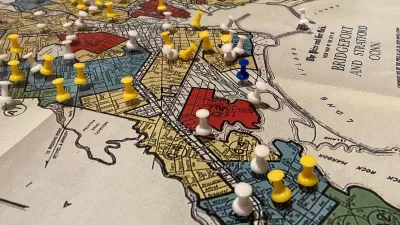The ugly story of the fence between a public housing community called New Haven and the nearby "middle class" community of Hamden, Connecticut will soon be over, but not because Hamden suddenly gained enlightenment.
"[Dillard Bennett's] family moved to New Haven from Georgia in 1959, seeking an escape from segregated buses and racial violence. Instead, they found what Mr. Bennett, who is black, called a signal that 'hatred for black folks' endures: 1,500 feet of thickly woven metal, enclosing a cluster of public housing projects on three sides," reports Benjamin Mueller.
Beyond it's literal presence, the fence also has a strong symbolic effect as a border between two worlds. "Built by Hamden in the 1950s to keep crime out of an aspiring middle-class neighborhood, the fence choked off access to jobs for public housing residents and obstructed emergency responders. Anger festered in the projects, and unemployment rates surpassed 75 percent. By 1990, New Haven’s violent crime rate nearly tripled the national average. Rocks sometimes flew over the fence, once battering a Hamden school bus."
But that's about to change, because recently "excavators began tearing down parts of the fence to make way for three roads that will eventually connect the public housing projects to Hamden — the first breach in this border in half a century. The first road is expected to poke through by September."
Unfortunately, the fence is not coming down out of the goodness of Hamden hearts. Rather, the Department of Housing and Urban Development discovered, after an investigation onto discriminatory housing practices, that the fence is actually on New Haven property, which is allowing the fence to come down despite the passionate protests of Hamden's residents.
FULL STORY: In Connecticut, Breaking Barrier Between a Suburb and Public Housing

Planetizen Federal Action Tracker
A weekly monitor of how Trump’s orders and actions are impacting planners and planning in America.

Maui's Vacation Rental Debate Turns Ugly
Verbal attacks, misinformation campaigns and fistfights plague a high-stakes debate to convert thousands of vacation rentals into long-term housing.

Restaurant Patios Were a Pandemic Win — Why Were They so Hard to Keep?
Social distancing requirements and changes in travel patterns prompted cities to pilot new uses for street and sidewalk space. Then it got complicated.

In California Battle of Housing vs. Environment, Housing Just Won
A new state law significantly limits the power of CEQA, an environmental review law that served as a powerful tool for blocking new development.

Boulder Eliminates Parking Minimums Citywide
Officials estimate the cost of building a single underground parking space at up to $100,000.

Orange County, Florida Adopts Largest US “Sprawl Repair” Code
The ‘Orange Code’ seeks to rectify decades of sprawl-inducing, car-oriented development.
Urban Design for Planners 1: Software Tools
This six-course series explores essential urban design concepts using open source software and equips planners with the tools they need to participate fully in the urban design process.
Planning for Universal Design
Learn the tools for implementing Universal Design in planning regulations.
Heyer Gruel & Associates PA
JM Goldson LLC
Custer County Colorado
City of Camden Redevelopment Agency
City of Astoria
Transportation Research & Education Center (TREC) at Portland State University
Jefferson Parish Government
Camden Redevelopment Agency
City of Claremont





























